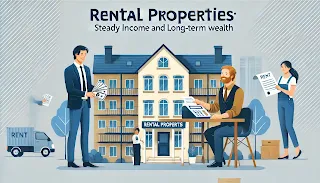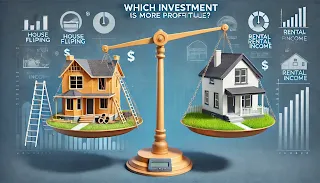House Flipping vs. Rental Properties: Which is More Profitable?
House Flipping vs. Rental Properties: Which is More Profitable?
When it comes to real estate investing, two popular strategies often come to mind: house flipping and rental properties. Both can be lucrative, but they each come with their own set of risks, rewards, and time commitments. If you're trying to figure out which investment path is right for you, this guide will help you make an informed choice.
1. House Flipping: Quick Profits but High Risk
House flipping is all about purchasing undervalued properties, sprucing them up, and then selling them for a profit.
✅ Pros of House Flipping:
✔ Fast Returns – You can see profits in just a few months instead of waiting years.
✔ No Long-Term Management – Forget about dealing with tenants or ongoing maintenance hassles.
✔ High ROI Potential – Savvy investors can score returns of 20-50% on each flip.
❌ Cons of House Flipping:
❌ High Upfront Costs – You’ll need a significant amount of capital for both the purchase and renovations.
❌ Market Dependent – Your profits hinge on a robust housing market.
❌ Unexpected Expenses – Renovation costs can sometimes get out of hand.
📌 Example of House Flipping Profit Calculation
Purchase Price: $150,000
Renovation Costs: $30,000
Closing & Holding Costs: $15,000
Sale Price: $220,000
Profit = $25,000
2. Rental Properties: Steady Income and Long-Term Wealth
Investing in rental properties means buying real estate and renting it out to tenants for a steady stream of passive income.
✅ Pros of Rental Properties:
✔ Consistent Cash Flow – Monthly rent payments provide a reliable income source.
✔ Long-Term Appreciation – Properties generally increase in value over time.
✔ Tax Benefits – Deductions for depreciation and mortgage interest can help lower your tax bill.
❌ Cons of Rental Properties:
❌ Tenant Issues – Late payments and evictions can be a real headache.
❌ Maintenance & Repairs – Properties require ongoing upkeep.
❌ Slow ROI – It can take years to see substantial returns.
📌 Example of Rental Property Profit Calculation
Purchase Price: $200,000
Monthly Rent: $2,000
Mortgage & Expenses: $1,500
Cash Flow = $500/month ($6,000/year)
Appreciation Potential: 3-5% per year
3. Which Investment is More Profitable?
Final Verdict: Which One Should You Go For?
Opt for House Flipping if you're after quick returns and have some experience with renovations under your belt.
On the other hand, go for Rental Properties if you're looking for a steady stream of passive income and want to build long-term wealth.
A lot of investors like to mix it up, using the profits from flipping houses to invest in rental properties for consistent income.
So, which strategy aligns best with your investment goals? It’s time to start building your real estate portfolio today!






Comments
Post a Comment